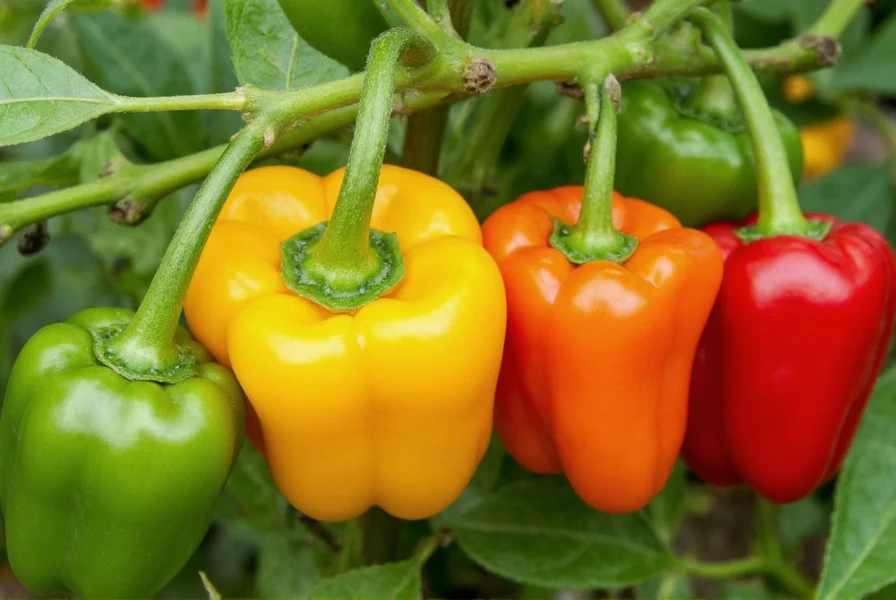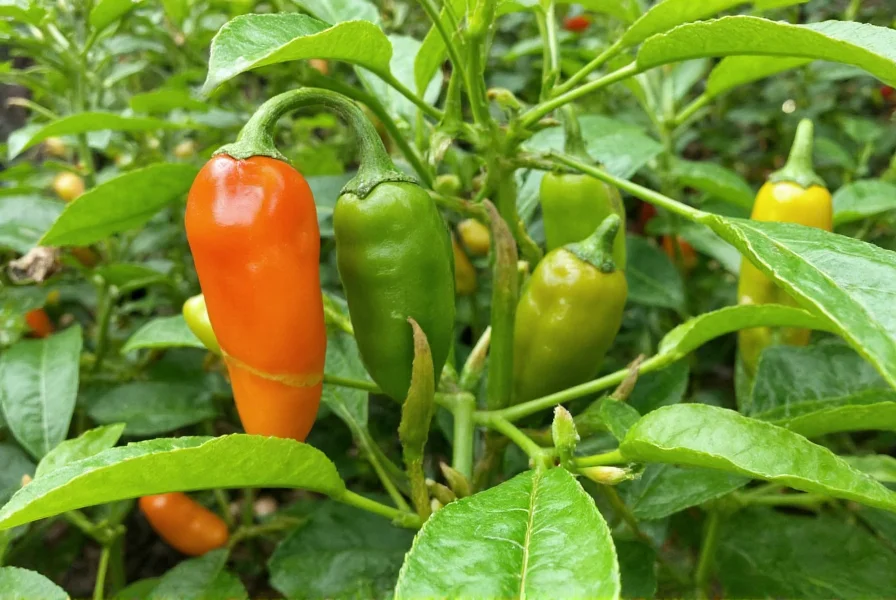Understanding pepper color provides valuable insights into flavor development, nutritional content, and optimal harvesting times. As peppers progress through their growth cycle, biochemical transformations create the vibrant spectrum we see in markets and gardens. This natural color evolution directly impacts taste profiles, with sweeter flavors emerging as chlorophyll breaks down and sugar content increases.
The Science Behind Pepper Color Development
Pepper pigmentation follows a predictable biological pattern governed by plant genetics and environmental factors. Chlorophyll dominates in immature peppers, creating the characteristic green color. As ripening occurs, chlorophyll degrades while other pigments become visible:
- Carotenoids produce yellow, orange, and red hues
- Anthocyanins create purple and black tones
- Chlorophyll breakdown reveals underlying colors
This transformation typically takes 2-4 weeks after the fruit sets, depending on pepper variety and growing conditions. Temperature, sunlight exposure, and nutrient availability all influence the speed and intensity of color development. The complete ripening process represents the pepper's natural progression toward seed maturity and dispersal.
| Pepper Color | Ripeness Stage | Primary Pigments | Days to Maturity |
|---|---|---|---|
| Green | Immature | Chlorophyll | 60-75 days |
| Yellow | Early mature | Carotenoids | 75-85 days |
| Orange | Mid-mature | Carotenoids | 80-90 days |
| Red | Full mature | Lycopene, Capsanthin | 85-100 days |
| Purple/Black | Varietal specific | Anthocyanins | Varies by variety |
Flavor Differences Across Pepper Colors
Color serves as a reliable indicator of flavor development in peppers. Green bell peppers deliver a grassy, slightly bitter taste profile with crisp texture. As peppers transition through yellow and orange stages, sweetness gradually increases while bitterness decreases. Fully ripened red peppers offer the sweetest, most complex flavor with subtle fruity notes and thicker walls.
For chili peppers, color changes often correlate with heat level variations. Many varieties like jalapeños start green and mild, becoming progressively hotter as they ripen to red. However, some specialty chilies maintain consistent heat regardless of color. The relationship between pepper color and spiciness depends on both variety and growing conditions.
Nutritional Value by Color Category
Nutrient density increases significantly as peppers mature. Red peppers contain nearly 11 times more beta-carotene and 1.5 times more vitamin C than their green counterparts. Each color stage offers unique phytonutrient benefits:
- Green peppers provide good vitamin C and fiber but lower overall antioxidant levels
- Yellow and orange peppers offer elevated vitamin A and carotenoids like lutein
- Red peppers deliver maximum vitamin C, beta-carotene, and lycopene
- Purple varieties contain anthocyanins with potent antioxidant properties
Research shows fully ripened red peppers contain up to 20% more vitamin C than green peppers harvested from the same plant. The extended time on the vine allows for greater nutrient accumulation and phytochemical development.

Culinary Applications for Different Colored Peppers
Chefs select pepper colors based on desired flavor profiles and visual presentation. Green peppers work best in dishes requiring crisp texture and sharp flavor, such as fajitas or stir-fries. Yellow and orange peppers add sweetness and vibrant color to salads and roasted vegetable medleys. Red peppers excel in sauces, stuffed preparations, and dishes where maximum sweetness enhances flavor complexity.
When planning meals, consider how pepper color affects both taste and nutritional value. For raw applications like salads, mix multiple colors for visual appeal and nutrient diversity. In cooked dishes, add green peppers earlier in the cooking process while introducing red peppers later to preserve their delicate sweetness.
Growing Tips for Optimal Color Development
Gardeners can influence pepper color development through proper cultivation techniques. Consistent watering prevents stress that might stunt color progression. Adequate potassium supports pigment production, while excessive nitrogen can delay ripening. Allowing peppers to remain on the plant until fully colored maximizes both flavor and nutritional content.
Some varieties naturally develop unique color patterns. The 'Purple Beauty' bell pepper transitions from purple to red, while 'Golden California Wonder' moves from yellow to orange. Understanding these natural progression patterns helps gardeners harvest at precisely the right moment for desired color characteristics.

Common Misconceptions About Pepper Colors
Many gardeners mistakenly believe different colored peppers come from separate plant varieties. In reality, most bell peppers start green and change color as they mature. The common practice of harvesting green peppers actually means picking them before full ripeness. This early harvest increases yield but sacrifices nutritional benefits and sweetness.
Another misconception involves heat levels in chili peppers. While some varieties become hotter as they ripen, others maintain consistent spiciness regardless of color. The Scoville rating depends more on genetics than color stage for many pepper types.
Conclusion: Making Informed Pepper Choices
Pepper color serves as nature's labeling system, revealing important information about ripeness, flavor, and nutritional content. By understanding these color indicators, consumers and growers can make better decisions about harvesting, purchasing, and culinary applications. Whether selecting peppers for maximum vitamin content or specific flavor profiles, color provides valuable guidance for optimizing both taste and health benefits.
Frequently Asked Questions
Why do peppers change color as they ripen?
Peppers change color due to biochemical transformations during ripening. Chlorophyll (green pigment) breaks down while carotenoids (yellow, orange, red) and anthocyanins (purple) become visible. This natural process indicates increased sugar content and nutrient development as the pepper matures toward seed dispersal readiness.
Are red peppers just ripe green peppers?
Yes, for most bell pepper varieties, red peppers are simply fully ripened green peppers. The same plant produces green peppers first, which gradually change to yellow, then orange, and finally red as they mature on the vine. This extended ripening period increases sweetness and nutritional content compared to early-harvested green peppers.
Do different colored peppers have different nutritional values?
Absolutely. As peppers ripen and change color, their nutritional profile improves significantly. Red peppers contain nearly 11 times more beta-carotene and up to 20% more vitamin C than green peppers from the same plant. Each color stage offers unique phytonutrients - yellow/orange peppers provide lutein, red peppers deliver lycopene, and purple varieties contain anthocyanins with antioxidant properties.
Why are green peppers cheaper than other colors?
Green peppers cost less because they're harvested earlier in the ripening process, allowing farmers to get more harvests from the same plants. The shorter time on the vine means lower production costs per pound. Fully ripened colored peppers require additional growing time, increasing resource investment and reducing overall yield per plant, which translates to higher market prices.
Can I ripen peppers off the plant?
Yes, peppers can continue ripening after harvest when stored at room temperature away from direct sunlight. Place them in a paper bag with ethylene-producing fruits like bananas to accelerate the process. However, vine-ripened peppers generally develop better flavor and nutritional content than those ripened off the plant, as the plant continues to supply nutrients during on-vine maturation.











 浙公网安备
33010002000092号
浙公网安备
33010002000092号 浙B2-20120091-4
浙B2-20120091-4